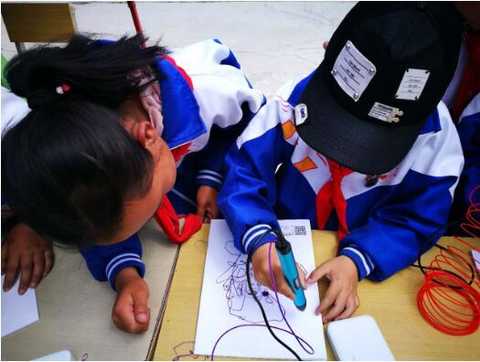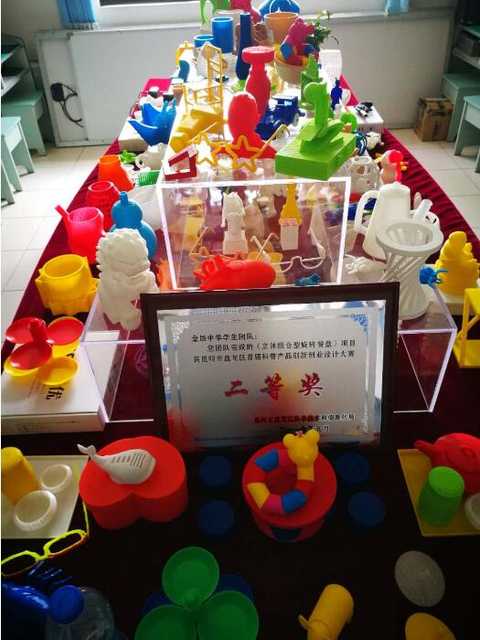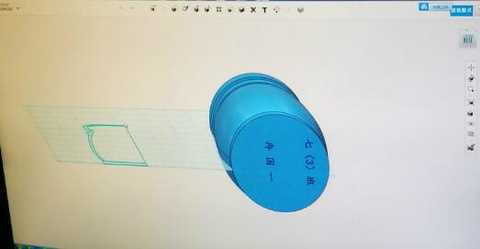When each school has a 3D printer, how far is it from the maker education?
(Jiantang Primary School 3D Printing Experience Event) [Huicong Education Equipment Network] 3D printing, robots, maker labs, STEAM labs. In recent years, these new terms have spread from the industrial sector to public schools, extending the maker/STEAM education to primary and secondary schools, but such quality Education resources are often concentrated in first-tier cities such as Beijing, Guangzhou and Shenzhen. In the third- and fourth-tier cities and areas with weak educational resources, there are still a large number of teachers and students who have not been exposed to such new ideas. Yunnan Province, with the primary goal of education balance, is among them. one. At the end of 2015, the Yunnan Provincial Department of Education purchased 6,000 sets of 3D printing equipment, which was distributed to more than 5,500 primary and secondary schools across the province to improve the conditions for running schools in weak schools, so that primary and secondary schools in various states have access to cutting-edge technology and educational concepts. . And when there is a 3D printer in each school, how does Maker Education fall in each school? The mustard heap was found in schools in various provinces of Yunnan Province, and the popularity of hardware was only the first step of the Long March. After the 3D printer is in school “Teacher, can you print football?†At the 3D printing experience event at Jiantang Primary School in Shangri-La, Yunnan Province, the children watched the magical machine in front of a printer, and some students stood excitedly in front of the scanner. Waiting for the avatar to be scanned and then printed out, there are also many students who are lining up to play 3D printing pens. When the staff at the scene told them that the images drawn with this stroke could be taken down and taken away, the students couldn't believe it with their eyes wide open, this was their first contact with 3D printing. The principal was also interested in scanning his avatar before the booth to experience the surprises of 3D printing technology. (Jiantang Elementary School students use 3D printing pens for the first time) It is understood that Shangri-La's Diqing Prefecture has issued 33 sets of equipment, which are distributed to the Shangri-La City, Deqin County and Weixi County. Jiantang Primary School is also assigned a 3D printer. However, the science teacher of the school told me that the equipment is not yet open to students. The teachers are in the stage of initial understanding and learning, and there are not enough conditions to open the course. The principal hopes to stimulate students' interest in 3D printing through this activity, and then try to open interest classes in the school. The same is true of Deqin County, which is visited in the mustard heap. Last year, Deqin’s small director, Shi Sangongbu, went to Kunming to participate in a three-day training camp for key teachers. But this is not enough for him. “They are all big lessons, I can’t listen at all. understand". Since then, the project cooperation company Fang Zhenzhong Hengda sent engineers to the local school to do two trainings, trying to get teachers to get started as soon as possible, the information technology teachers of the five local primary and secondary schools have participated in the training. Deqin, a small Zachishm, learned very quickly and sent his work to Kunming to participate in the competition. As an information technology teacher who just graduated, she likes to study new things. Under the proposal of the director, she plans to I will open a 3D printing interest class at school during the semester. (Jianmin Middle School Student Works) Some of these schools have already started, and they are currently in the form of interest activity classes. Taking Jianmin Middle School in Honghe Prefecture as an example, information technology teacher Xu Zhu is in charge of this course. She said that the current course has just started, once a week, the main content is to let students understand the concept and principle of 3D printing, the basics of learning software. The method of operation, as well as printing a simple model. This course is a new challenge for both her and her students. Prior to this, Xu Zhu had not been exposed to 3D printing. After attending a training camp in the province, she has been exploring how to carry out teaching. She often discusses problems in model design and teaching with other teachers in the QQ group. In every school that has already started classes, there is bound to be a teacher who loves maker education. a doctor's lab supported by a teacher "You have taught the creatures to come again, let me be a computer teacher." Some time ago, I went to participate in 3D printing teacher training. Some teachers tweeted, and Liang Yun took the computer teacher's rice bowl as a biology teacher. Liang Yun is a biology teacher who has been teaching for nearly 20 years in Kunming Jinchen Middle School. At the same time, he is the director of the teaching department. Since the opening of the 3D printing interest class, his amateur energy has almost slammed on it. Reminiscent of how this class should be done, Liang Yun fiddled with the student's work, and introduced to us, after school at 4:30 pm every day, he will stay in this small technology lab, teach students to design their own works. (Jinchen Middle School Student Model Booth) The lab is filled with hundreds of works designed by students in the past year. The three-dimensional combination plate in the lower left corner won the competition in Panlong District last year. This classroom was originally a model innovation-based science and technology innovation laboratory declared in 2009. In the past few years, 36 machine tools, various hand-made works and self-made teaching aids were placed. Last year, Liang Yun was transformed into 3D printing. Guest laboratory. In December 2015, 3D printing equipment was sent to Jinchen Middle School. Liang Yun, who likes to explore new things, began to search for tutorials on the Internet to study this new technology. He found that 3D printing is more malleable than the previous manual model making, and there is unlimited extension space in the model design, which is more educational for students. "I haven't found the end yet," and for more than a year, he claimed to be just getting started. When Liang Yun brought his designed and printed model to the biology class, the students were very excited and curious. Therefore, he decided to transfer the focus of the technology lab to 3D printing. By the advantage of the director of the teaching department, he assembled a batch of old computers that were eliminated from the school, selected 9 students from the first grade, and opened the first interest class in April of the following year. Design the model. Liang Yun didn't think that it was not the same as the biology lesson that was taught by the hand. This course was much more difficult to teach. Because students didn't have a concept of transition from plane to three-dimensional, it took three lessons to teach the basics. "For example, A certain component is erected, not laid flat. It takes several times for students to understand that they have no concept of space and three-dimensionality. Liang Yun found that 3D printing has requirements for students’ age and thinking ability. He also explored the best teaching methods in practice. For example, if students don't understand the three-dimensional concept, let him first draw on the plane and assemble the model. "Now I am more confident." Liang Yun smiled. Say. This year, Liang Yun recruited the second batch of students because he gave a presentation at the parent meeting and reported the results of the last semester to the parents. The acceptance of the parents increased, and almost half of the students in each class signed up, but limited. For hardware equipment and teachers, he only enrolled 36 students. The time of interest class is after 4:30 in the afternoon and after 6:00, "often, at 7:00, students are still unwilling to go." When talking about students, Liang Yun is very happy. After a period of training, he is pleasantly surprised, except According to the gourd painting, the students can also add their own ideas. Liang Yun brings up a model of the student design in the computer. This is a stool. He explained that although the work looks simple, the students joined. Your own ideas, including multi-faceted model design, bases, covers, and more. (model designed by students) After each lesson, Liang Yun will ask students to submit models, help them correct the problems, and continually modify them. Every once in a while, he will print out the models and reward them to the students, so that students can find problems in the model design by observing the finished products. For example, the ratio is wrong, the structure is unreasonable, and so on, and then the model is modified. “The most important thing is to become a truly meaningful work.†Liang Yun teaches students so much. He encourages students to add their own ideas and ideas to their work to solve real life problems. This is the education of makers. Really. "I can't do this thing, but I personally think it is very valuable, especially when I take the students to make the work, it is very fulfilling." From the 0 to 1 step, the biological teacher Liang Yun will Keep on going. Hardware popularity is only the first step Let Maker Education fall on campus. This is the original intention of Yunnan Province to popularize 3D printing system in primary and middle schools. One year after the hardware equipment was issued, the Yunnan Provincial Audio-visual Education Center mentioned in the "2017 Work Highlights" released earlier this year: “Continue to promote the application and training of 3D printing integrated system project schools, launch pilot projects for 3D printing courses, and promote teaching reform and educational innovation.†At the same time, the Yunnan Provincial Department of Education promoted the 3D printing curriculum demonstration school project in various states, and selected a suitable local landing mode to promote it locally. Liang Yun is negotiating with the principal to apply for the 3D printing activity class as a compulsory course for the first-year students, and arrange one lesson per week. If the principal promises to come down, for him, there are a lot of real problems: teachers, courses, equipment, etc... At present, the school only has his own 3D printing class teacher, which is a new course without curriculum standards, curriculum system and fixed teaching materials. He also realized that there is still a long way to go before turning the 3D printing course from 0 to 1 and turning it from a stream of interest classes to a fixed compulsory course. In addition, schools need more hardware equipment. Considering the factors of cost, environmental protection and safety, the 3D equipment and technology entering the school are not at the forefront of the market. The modeling takes a long time, and it takes three hours to complete the printing. Even the works with higher precision requirements need even More than ten hours, a printer is difficult to meet the daily teaching needs. For primary and secondary schools in the compulsory education stage, there is no additional funding for such “non-critically needed†teaching equipment. Liang Yun told me that the current four devices are barely enough, but three of them are resources borrowed from external companies. The challenge faced by Liang Yun is also a common problem for Maker Education to enter the campus. Last year, the STEAM education report issued by the Information Management Center of the Ministry of Education showed that after the STEAM program was enrolled, 50% of the schools were carried out in the form of community activities, which was in a relatively marginal position. From a school perspective, due to the pressure of exams and the lack of teachers, the school does not have enough motivation to open such new courses as compulsory courses, most of which are school-based, interest-based or community activities. The same is true in Yunnan Province. The teachers in each school's 3D printing class are mainly part-time in science and technology classes and information technology teachers. The daily teaching tasks of teachers are relatively heavy, and there is not much energy devoted to extracurricular activities. Naturally, the driving force of teachers themselves is one of the key factors for a school to start a long-term course. The lack of systematic professional courses is one of the common problems in the current education of Maker Education. However, in terms of courses and teachers, it is difficult to solve the shortcomings of pre-service teacher training in the short term. The current solution is still the cooperation between schools and enterprises, and the introduction of external quality resources. In the after-sales service, Suizhong Hengda found that the common problem in schools is that teachers are very active in setting up innovative laboratories, but the teaching resources are insufficient. Therefore, the team is planning to build an online learning platform with 3D printing courses as the core. The teacher provides online teaching resources and teacher training. At the same time, they developed a set of basic materials for the school's reference. “For 3D printing, there are many different courses across the country (including research institutions and educational institutions), but I have not found the most suitable course for teaching students.†Liang Yun, who is groping in teaching, believes that teachers need to constantly think about how Teach in order to allow students to better absorb and, more importantly, combine technology with curriculum to give students more inspiration in the model design process. Perhaps primary and secondary school teachers are generally participants and designers of the maker class, not just consumers, and the maker education will truly integrate into the campus. Editor in charge: Jia Wei Hybrid Fabric,Mixed Fabric,Hybrid Textiles,Carbon Kevlar Hybrid Fabric Jiangyin Phecda New Material Technology Co., Ltd , https://www.phecdacomposite.com



